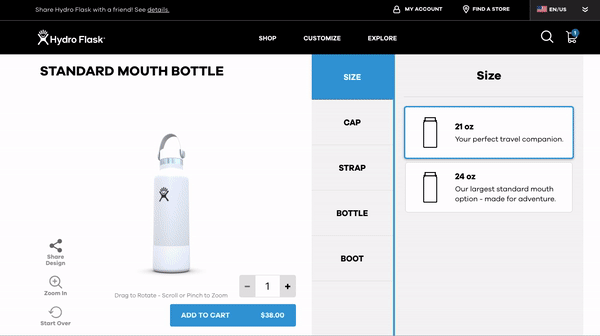
A fallacy that many ecommerce businesses continue to believe in is that if you build it, shoppers will come. While it may not be a complete fallacy, for it to have any real influence on your business, we may have to revise the statement.
Maybe it should be, “if you build it correctly and evolve with expectations, shoppers will keep coming back.”
Today’s startups and established online retailers compete on the ecommerce shopping experience just as much as the products on offer and prices attached to these items. Ecommerce has become a vital component for brands – and with Labor Day around the corner, let’s look at how you can improve the shopping experiences for your online shoppers.
Keep in mind that:
An ecommerce shopping experience is the sum of all touchpoints and interactions you provide to your visitors on your site. It includes the feelings and thoughts that your site evokes from potential customers as they progress through the buying journey.
As customers’ expectations evolve constantly, ensuring you have a frictionless ecommerce shopping experience can make or break your business. What has become clear is that you can no longer compete only on price and product quality.
With an improved ecommerce shopping experience, you can:
To help you provide better ecommerce shopping experiences, let’s look at ten things you can do to convert more visitors into loyal customers on your site.
If you haven’t done so this year, start with a fresh audit of your current shopping experience. You may even have some backlog items where customers made suggestions in the past that you haven’t had time to action.
Take this information, and then ask the following questions:
By going through your current experience with a fresh pair of eyes, you can quickly identify areas that are ripe for further improvement.
The best online shopping experience is one that keeps up with the latest trends in consumer behavior and provides a user-friendly way to interact with all your products. Usability requires a simplified, easy-to-use, and intuitive website layout and design.
The rule of thumb for usability is to never let a visitor have to think about how to do something by making every feature as clear as day.
Reconsider your site’s usability by:
Visitors who come across your site will have different motivations and expectations. Identifying the different personas that will use your site can help you to improve usability and remove any friction points from the buying journey.
The three main personas that you’ll need to cater for include:
For each of these personas, you may have to tweak your experience and features according to their underlying motivations. A simple search function will be great for first-time visitors, but for experienced shoppers, you may have to provide more filtering options. Similarly, if it’s a returning visitor, you can use their purchase history to make the shopping experience more personalized and engaging.
There’s a reason why the best ecommerce experiences have a seamless checkout process. This is often the point where the online shopping experience creates the most friction in the customer’s buying journey.
Any complication during this stage will see a customer abandon their cart and continue shopping elsewhere. Something as simple as a form’s formatting can immediately put a customer off if it doesn’t work as required. Ensure that your entire checkout process works seamlessly, and if you make any changes, test every new feature or form on every device type.
Additionally, you should:
Shoppers no longer want to buy from your ecommerce site from their computers only. If you haven’t done so already, you need to optimize your site for mobile and handheld devices immediately.
Mobile ecommerce surpassed all other devices by 2021, responsible for 54% of total sales over the last year. You’ll need to find intuitive ways to make mobile ecommerce experiences just as convenient for shoppers as your main website. To improve the mobile experience, include features like autofill for forms, set fields to use the right popup keyboards (QWERTY vs numbers), and optimize the loading of images for phones or tablets.
If your site takes too long to load on a mobile device, you may need to reduce the data per page to ensure you don’t lose customers who aren’t willing to wait.
An emerging trend in ecommerce is product personalization and customization. Customers want to see what a product will look like in different colors, add their own personalized messages, or calculate the cost of any customized options you have available.
Technologies like 3D product rendering, augmented reality, and easy-to-use configurators can drive your conversions by engaging your customers. More companies now have some personalization features for products, and customers need to know about these options while also having the ability to see the changes they make in real-time.
One of our favorites is Hydro Flask’s new MyHydro 3D product personalization experience.

Via Hydro Flask
Customers don’t just buy online anymore – they want to do everything online. From customizing a product to communicating with your company and accessing your after-sales services, each element influences your customer’s perception of your brand. Whenever a customer wants an answer, you’ll need to provide them with the information at a moment’s notice.
Include customer service options like:
Content helps you to acquire and convert new customers if they trust you as an authority on a subject. When you post blogs and other content, ensure that these pieces add value to your customers and go beyond just providing product blurbs.
This may include video tutorials, infographics, and detailed product reviews (even from other customers). Customers who find valuable information on your site will share the content with their friends and families, attracting more visitors to your ecommerce business. You also don’t have to limit your content to the products on the site, as any valuable information will help build brand trust between you and your customers.
The only way to improve your online shopping experience is by having an accurate set of metrics available to contrast and compare. You can conduct surveys to measure satisfaction, use click-through rates to measure product sentiment, and use features like your Net Promoter Score (NPS) to gauge your success. Analytics is the best way to measure your success (or churn) and identify areas where you can improve your ecommerce business.
Finally, customers want to feel valued when they shop from you. You can offer returning customers discounts, but also remember to send a thank-you message to any new shoppers. Staying in contact with customers is the best way to increase your conversions and maintain brand loyalty through the buying journey.
ConfigureID provides you with a comprehensive suite of product customization and ecommerce tools to boost your site’s visual shopping experiences. From easy-to-use product configurators to rich and engaging 3D renders of your products, ConfigureID can assist with increasing your conversions by delivering enjoyable and engaging experiences to your visitors.
To see how ConfigureID can help you provide product personalization and customization experiences to your customers, schedule a demo today.